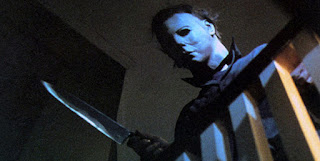Slasher movies are one of the most predominant sub-genres within the Horror category, and are highly popular amongst horror fans. Despite many slasher films having vastly different storylines, they all abide to a similar formula and abide to the same conventions.
The Killer
Of course, A killer is one of the main components of a slasher film. Although they are usually male, their identity is commonly hidden through the use of a mask, and is revealed (if at all) at the end of the film. Even if the killer's identity is known by the audience, they still keep their face hidden by the mask. This, combined with the fact that he usually has no or little dialogue, portrays the killer as having a sinister, omnipresent and threatening nature. His back-story is likely to include some sort of childhood trauma that lead him into becoming the homicidal maniac he is today, creating some sort of sympathy in the viewer, despite being aware of the horrific crimes committed by him throughout the film.
The Heroine
Although the slasher genre sometimes causes controversy for being arguably sexist, the 'heroic' role is commonly acquired by a female. It is evident to the audience that the Heroine (or The Final Girl) is conservative; she doesn't drink alcohol or take any drugs, and is most often a virgin. It is notable that a particular skill/ set of skills is possessed by the character, as this is known to help them defeat the killer in the final battle.
The Victims
The victims are one of the most substantial elements of the Slasher sub-genre, and are often teenagers, most commonly in high school, and have morals entirely unparalleled to that of the Heroine. Rarely does the killer pick off these characters specifically because of their immoral behaviour, however the unspoken code of slasher films is that they must be punished for their wrong doings. As sadistic as it may sound, fans of the genre tend to look forward to the deaths of these types of characters because they believe they deserve it.
However it isn’t always bad characters that get killed off, ultimately many characters die who, in any way, have an association with the main character. Sometimes a protagonist is killed off for shock value, for example Randy in Scream 2.
Violence
It is obvious that Slashers differ from other horror sub-genres when looking at the violence depicted throughout the films, and instead of focusing on such themes as character development, concentrate on the macabre gore. The storylines within Slashers hence allow the killer the opportunity to cause mayhem amongst the characters. The deaths are extremely graphic and bloody, and are caused by a particular weapon of the killer’s choice, for example Jason Vorhees’ iconic machete.
John Carpenter's 'Halloween', made in 1978 is considered as being the first "true" slasher in terms of using all of these components within the same project, therefore setting the standard by which all other films within this sub-genre are viewed upon. 'Halloween''s success led to 'Friday the 13th' in 1980, which then opened the door for hundreds of similar during the 1980s, such as 'A Nightmare on Elm Street' containing the original and infamous villain, Freddy Krueger.
By the start of the '90s, the slasher concept had worn thin, with fewer and fewer films at the box office relating to the genre. However in 1996, Wes Craven's 'Scream', became the biggest hit the genre had ever seen, featuring all of the main codes and Conventions of the slasher sub-genre with a mildly ironic twist.





No comments:
Post a Comment